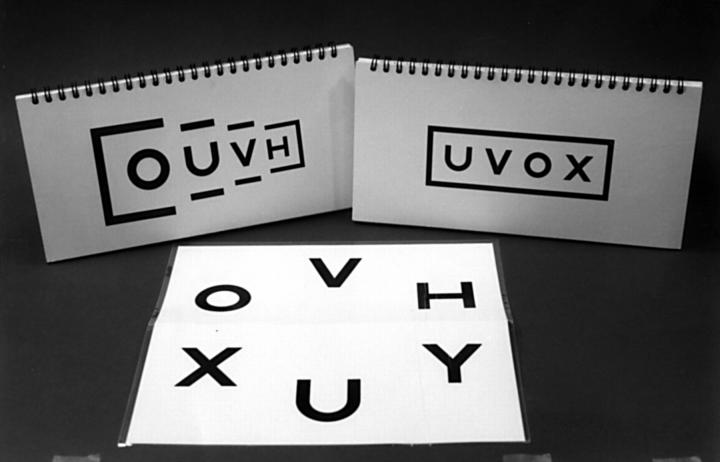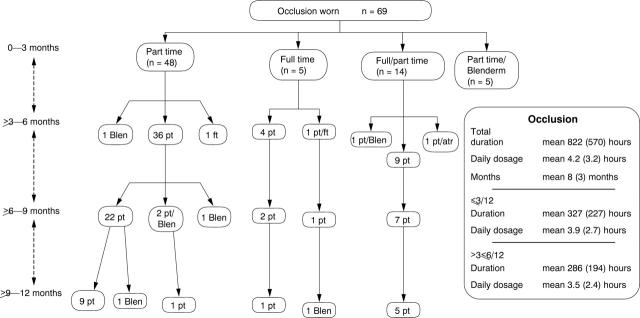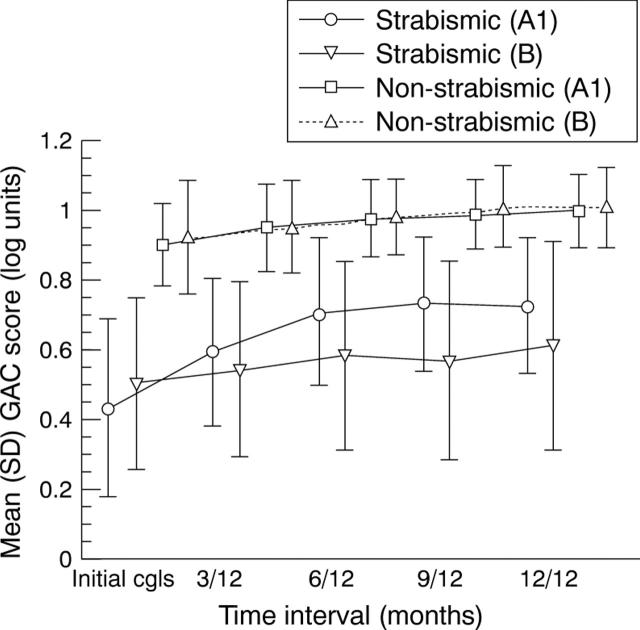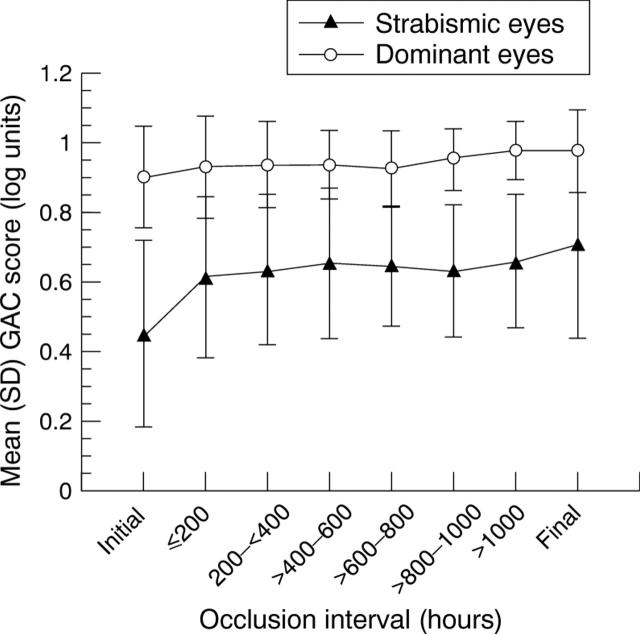Abstract
BACKGROUND/AIMS—The study of occlusion efficacy in amblyopia has been hampered by the use of non-logMAR acuity tests and a failure to assess threshold acuity for both eyes. These issues are addressed in the current study which compares the effect of spectacles alone and spectacles in combination with occlusion, with the use of the logMAR crowded test. METHODS—Changes in uniocular and interocular acuity differences were compared for two age matched groups of previously untreated children with strabismic amblyopia: one compliant with spectacles only (n = 17, mean 6.2 (SD 2.5) years) and the other with spectacles and occlusion (n = 69, mean 5.1 (1) years) over a 1 year period. Changes in logMAR acuity were also analysed for a larger occluded group (n = 119) in response to successive 200 hour blocks of occlusion up to ⩾1000 hours, in an attempt to isolate an optimal occlusion regime. RESULTS—Visual acuity improved for more of the amblyopic eyes of the occluded (74%) than the spectacles only group (59%), and only one child from the latter group deteriorated. Mean visual acuity improved for both eyes of both treatment groups, but the change was significantly larger for the strabismic eyes of the occluded group overall and within the first 6 month period (p <0.05). Occlusion was only effective for the first 400 hours worn. Subsequent visual improvement was bilateral and symmetrical. CONCLUSION—Occlusion is more effective in the treatment of strabismic amblyopia than spectacles alone, and the effect is optimal within the first 6 months of wear. In terms of occlusion duration, maximal improvement occurs in response to 400 hours of occlusion wear or less, and to full time occlusion. Visual maturation continues, but is retarded for amblyopic eyes.
Full Text
The Full Text of this article is available as a PDF (193.0 KB).
Figure 1 .
Logmar crowded test (Glasgow acuity cards).
Figure 2 .
Flow diagram of occlusion at 3 monthly intervals for group A1 (n = 69). ft = Full time, pt = part time, Blen = Blenderm, atr = atropine.
Figure 3 .
Mean GAC score for the strabismic and dominant eyes of groups A1 (n = 69) and B (n = 17) for 3 monthly intervals up to 12 months.
Figure 4 .
Mean (SD) GAC scores preocclusion, and for occlusion time intervals up to >1000 hours, and final acuity for strabismic/mixed amblyopes (n = 119).
Selected References
These references are in PubMed. This may not be the complete list of references from this article.
- Abrahamsson M., Sjöstrand J. Contrast sensitivity and acuity relationship in strabismic and anisometropic amblyopia. Br J Ophthalmol. 1988 Jan;72(1):44–49. doi: 10.1136/bjo.72.1.44. [DOI] [PMC free article] [PubMed] [Google Scholar]
- Assaf A. A. The sensitive period: transfer of fixation after occlusion for strabismic amblyopia. Br J Ophthalmol. 1982 Jan;66(1):64–70. doi: 10.1136/bjo.66.1.64. [DOI] [PMC free article] [PubMed] [Google Scholar]
- BROCK F. W., GIVNER I. Fixation anomalies in amblyopia. AMA Arch Ophthalmol. 1952 Jun;47(6):775–786. doi: 10.1001/archopht.1952.01700030794008. [DOI] [PubMed] [Google Scholar]
- BURIAN H. M., CORTIMIGLIA R. M. Visual acuity and fixation pattern in patients with strabismic amblyopia. Am Orthopt J. 1962;12:169–174. [PubMed] [Google Scholar]
- Beardsell R., Clarke S., Hill M. Outcome of occlusion treatment for amblyopia. J Pediatr Ophthalmol Strabismus. 1999 Jan-Feb;36(1):19–24. doi: 10.3928/0191-3913-19990101-05. [DOI] [PubMed] [Google Scholar]
- Bowman R. J., Williamson T. H., Andrews R. G., Aitchison T. C., Dutton G. N. An inner city preschool visual screening programme: long-term visual results. Br J Ophthalmol. 1998 May;82(5):543–548. doi: 10.1136/bjo.82.5.543. [DOI] [PMC free article] [PubMed] [Google Scholar]
- Ciuffreda K. J., Kenyon R. V., Stark L. Increased drift in amblyopic eyes. Br J Ophthalmol. 1980 Jan;64(1):7–14. doi: 10.1136/bjo.64.1.7. [DOI] [PMC free article] [PubMed] [Google Scholar]
- Epelbaum M., Milleret C., Buisseret P., Dufier J. L. The sensitive period for strabismic amblyopia in humans. Ophthalmology. 1993 Mar;100(3):323–327. doi: 10.1016/s0161-6420(13)32170-8. [DOI] [PubMed] [Google Scholar]
- Fielder A. R., Auld R., Irwin M., Cocker K. D., Jones H. S., Moseley M. J. Compliance monitoring in amblyopia therapy. Lancet. 1994 Feb 26;343(8896):547–547. doi: 10.1016/s0140-6736(94)91502-4. [DOI] [PubMed] [Google Scholar]
- Fielder A. R., Irwin M., Auld R., Cocker K. D., Jones H. S., Moseley M. J. Compliance in amblyopia therapy: objective monitoring of occlusion. Br J Ophthalmol. 1995 Jun;79(6):585–589. doi: 10.1136/bjo.79.6.585. [DOI] [PMC free article] [PubMed] [Google Scholar]
- Flom M. C., Bedell H. E. Identifying amblyopia using associated conditions, acuity, and nonacuity features. Am J Optom Physiol Opt. 1985 Mar;62(3):153–160. doi: 10.1097/00006324-198503000-00001. [DOI] [PubMed] [Google Scholar]
- Flynn J. T., Cassady J. C. Current trends in amblyopia therapy. Ophthalmology. 1978 May;85(5):428–450. doi: 10.1016/s0161-6420(78)35651-7. [DOI] [PubMed] [Google Scholar]
- Giaschi D. E., Regan D., Kraft S. P., Kothe A. C. Crowding and contrast in amblyopia. Optom Vis Sci. 1993 Mar;70(3):192–197. doi: 10.1097/00006324-199303000-00003. [DOI] [PubMed] [Google Scholar]
- Hess R. F., Holliday I. E. The spatial localization deficit in amblyopia. Vision Res. 1992 Jul;32(7):1319–1339. doi: 10.1016/0042-6989(92)90225-8. [DOI] [PubMed] [Google Scholar]
- Hess R. F., Howell E. R. The threshold contrast sensitivity function in strabismic amblyopia: evidence for a two type classification. Vision Res. 1977;17(9):1049–1055. doi: 10.1016/0042-6989(77)90009-8. [DOI] [PubMed] [Google Scholar]
- Hiscox F., Strong N., Thompson J. R., Minshull C., Woodruff G. Occlusion for amblyopia: a comprehensive survey of outcome. Eye (Lond) 1992;6(Pt 3):300–304. doi: 10.1038/eye.1992.59. [DOI] [PubMed] [Google Scholar]
- Lennerstrand G., Rydberg A. Results of treatment of amblyopia with a screening program for early detection. Acta Ophthalmol Scand Suppl. 1996;(219):42–45. doi: 10.1111/j.1600-0420.1996.tb00384.x. [DOI] [PubMed] [Google Scholar]
- Lithander J., Sjöstrand J. Anisometropic and strabismic amblyopia in the age group 2 years and above: a prospective study of the results of treatment. Br J Ophthalmol. 1991 Feb;75(2):111–116. doi: 10.1136/bjo.75.2.111. [DOI] [PMC free article] [PubMed] [Google Scholar]
- McGraw P. V., Winn B. Glasgow Acuity Cards: a new test for the measurement of letter acuity in children. Ophthalmic Physiol Opt. 1993 Oct;13(4):400–404. doi: 10.1111/j.1475-1313.1993.tb00499.x. [DOI] [PubMed] [Google Scholar]
- McGraw P. V., Winn B., Whitaker D., McFadzean R. Positional acuity in amblyopia: does a perceptual consequence of neural recruitment exist? Ophthalmic Physiol Opt. 1998 Sep;18(5):423–429. [PubMed] [Google Scholar]
- Moseley M. J., Fielder A. R., Irwin M., Jones H. S., Auld R. J. Effectiveness of occlusion therapy in ametropic amblyopia: a pilot study. Br J Ophthalmol. 1997 Nov;81(11):956–961. doi: 10.1136/bjo.81.11.956. [DOI] [PMC free article] [PubMed] [Google Scholar]
- Nucci P., Alfarano R., Piantanida A., Brancato R. Compliance in antiamblyopia occlusion therapy. Acta Ophthalmol (Copenh) 1992 Feb;70(1):128–131. doi: 10.1111/j.1755-3768.1992.tb02104.x. [DOI] [PubMed] [Google Scholar]
- Oliver M., Neumann R., Chaimovitch Y., Gotesman N., Shimshoni M. Compliance and results of treatment for amblyopia in children more than 8 years old. Am J Ophthalmol. 1986 Sep 15;102(3):340–345. doi: 10.1016/0002-9394(86)90008-5. [DOI] [PubMed] [Google Scholar]
- Scott W. E., Dickey C. F. Stability of visual acuity in amblyopic patients after visual maturity. Graefes Arch Clin Exp Ophthalmol. 1988;226(2):154–157. doi: 10.1007/BF02173306. [DOI] [PubMed] [Google Scholar]
- Simmers A. J., Gray L. S., Spowart K. Screening for amblyopia: a comparison of paediatric letter tests. Br J Ophthalmol. 1997 Jun;81(6):465–469. doi: 10.1136/bjo.81.6.465. [DOI] [PMC free article] [PubMed] [Google Scholar]
- Simons K., Preslan M. Natural history of amblyopia untreated owing to lack of compliance. Br J Ophthalmol. 1999 May;83(5):582–587. doi: 10.1136/bjo.83.5.582. [DOI] [PMC free article] [PubMed] [Google Scholar]
- Vaegan, Taylor D. Critical period for deprivation amblyopia in children. Trans Ophthalmol Soc U K. 1979;99(3):432–439. [PubMed] [Google Scholar]
- Woodruff G., Hiscox F., Thompson J. R., Smith L. K. Factors affecting the outcome of children treated for amblyopia. Eye (Lond) 1994;8(Pt 6):627–631. doi: 10.1038/eye.1994.157. [DOI] [PubMed] [Google Scholar]






